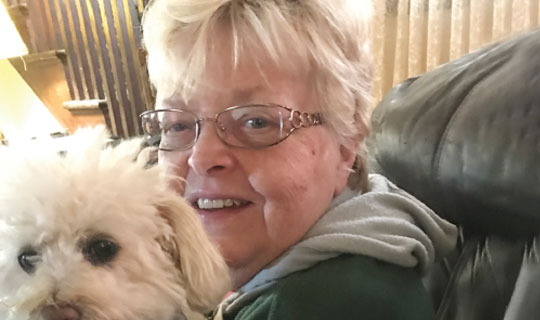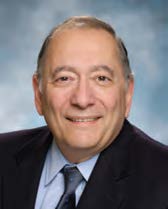“Barostim has been wonderful. It gives me energy, and I can do more.”

Theresa Rafferty’s heart failure had progressed to the point that she had little energy and could no longer do many of the activities she loved.
“I was mainly hanging around the house not doing much,” says the 80-yearold Staten Island resident. Having systolic heart failure meant her heart couldn’t pump forcefully enough to meet her body’s needs for blood and oxygen. “I used to take my dog over to the bay and walk her around, but it got so I couldn’t even walk her much in the neighborhood,” Rafferty says.
A groundbreaking procedure at Robert Wood Johnson University Hospital (RWJUH) in June 2021 changed all that. Rafferty regained much of her energy and started once again enjoying favorite activities such as having lunch with friends and taking longer walks with her dog.
The procedure implants a pacemaker-like device under the collarbone for a treatment known as Barostim baroreflex activation therapy. Barostim was approved by the Food and Drug Administration in 2019 and is the first medical technology to use neuromodulation, a technology that harnesses the power of the brain and nervous system to improve symptoms in patients with heart failure.
Stimulating Signals

The Barostim device connects to an electrode that lies on the carotid artery in the neck and stimulates a cluster of sensors called baroreceptors, explains John Kassotis, MD, a cardiologist at RWJUH and Professor and Director, Cardiovascular Fellowship and Education Programs, Rutgers Robert Wood Johnson Medical School, who specializes in clinical cardiac electrophysiology, is board-certified in advanced heart failure and performed Rafferty’s surgery.
Baroreceptors sense changes in blood pressure and other factors associated with blood flow. Signals from these baroreceptors help the brain regulate cardiovascular function. “These sensors in part tell the brain what hormones to release to allow organs like the heart to work properly,” Dr. Kassotis says.
In people with heart failure like Rafferty, this regulation system becomes out of balance. One effect is that too much adrenaline spills into the body, creating stress on the cardiovascular system. “That’s very bad for the heart,” Dr. Kassotis says.
With Barostim implanted, baroreceptors send the brain appropriate signals to restore balance, release less adrenaline and improve heart function. Arteries relax, allowing blood to course more easily through the body and reducing the heart’s exertion. Barostim also prompts the kidneys to reduce fluid in the body, lowering blood pressure and further relieving the heart’s workload. “Over a period of four to six weeks, Barostim reregulates the body and returns it to a more even homeostasis,” Dr. Kassotis says.
The implant procedure takes 45 minutes to an hour and involves a one-inch incision on the right side of the neck and a two-inch incision under the collarbone. The device is programmed to meet individual patient needs, and doctors can adjust it for best results. Its battery generally lasts five to six years.
Not all patients with heart failure are candidates for Barostim. The device is intended only for people who lack other treatment options for systolic heart failure, sometimes called heart failure with reduced ejection fraction (HFrEF), in which the left ventricle becomes weak and can’t contract properly.
“If you’re suffering from heart failure, consult with your treating physician to see if you specifically have systolic heart failure and may be an appropriate candidate for this intervention,” Dr. Kassotis says.
Quick Improvement
Barostim clearly can improve quality of life, Dr. Kassotis says. “People who receive it feel better and walk better,” he says. “On average, they can walk more than half a football field more distance after undergoing the procedure than before. That’s a lot for these patients.” Research now under way is expected to show that Barostim also helps people live longer by reducing risks associated with heart failure.
Rafferty can attest to the improvement she felt after successfully undergoing the Barostim procedure. “I had no pain and felt good right away,” she says. The implantation required her to spend just one night in the hospital for observation.
“Barostim has been wonderful,” Rafferty says. “It gives me energy, and I can do more. My mind is alert, my breathing is excellent and I can walk further—and want to walk further. I walk around stores. I go for walks with my dog. It’s made a big difference.”
What Is Heart Failure?
A healthy heart muscle continuously pumps blood through two upper chambers (atria) and two lower chambers (ventricles). Heart failure occurs when the muscle has trouble pumping enough blood to meet the body’s needs. To compensate, the heart may pump faster, the muscle may become larger and thicker, blood pressure may increase and the body may divert blood from less important organs.
Often silent at first, heart failure can lead to symptoms such as fatigue and difficulty breathing. As the heart fails to keep up with its workload, fluid can back up in the body’s tissues—a condition called congestive heart failure that can cause swelling and impair the function of vital organs such as the lungs.
Learn more about Barostim baroreflex activation therapy at Robert Wood Johnson University Hospital.